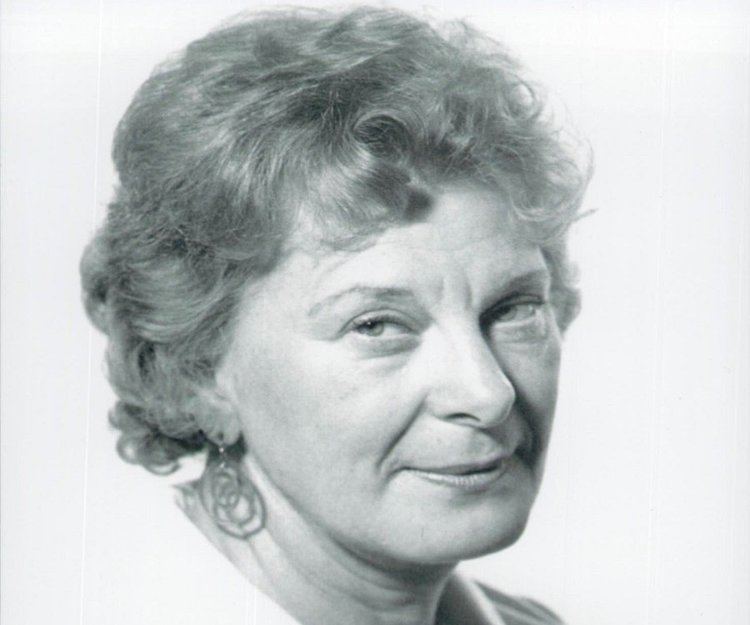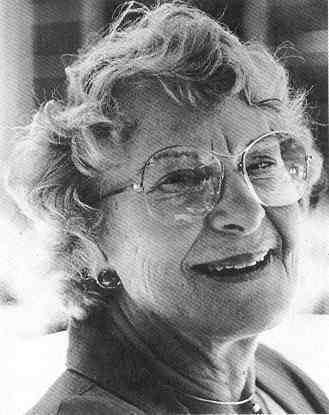Occupation social worker Name Virginia Satir | Children Ruth Satir, Mary Satir | |
 | ||
Spouse Norman Satir (m. 1951–1957), Gordon Rodgers (m. ?–1949) Siblings Russell Satir, Edith Satir, Roger Satir, Ray Satir Books The new peoplemaking, Peoplemaking, Conjoint family therapy, Your many faces, Satir step by step | ||
Virginia satir
Virginia Satir (26 June 1916 – 10 September 1988) was an American author and social worker, known especially for her approach to Family therapy and her work with family reconstruction. She is widely regarded as the "Mother of Family Therapy" Her most well-known books are Conjoint Family Therapy, 1964, Peoplemaking, 1972, and The New Peoplemaking, 1988.
Contents
- Virginia satir
- Virginia satir communication and congruence excerpt a thinking allowed dvd w jeffrey mishlove
- Early years
- Career as a therapist
- Work and influence
- Career as author
- I Am Me
- References

She is also known for creating the Virginia Satir Change Process Model, a psychological model developed through clinical studies. Change management and organizational gurus of the 1990s and 2000s embrace this model to define how change impacts organizations.
Virginia satir communication and congruence excerpt a thinking allowed dvd w jeffrey mishlove
Early years

Virginia Satir was born 26 June 1916 in Neillsville, Wisconsin, the eldest of five children born to Oscar Alfred Reinnard Pagenkopf and Minnie Happe Pagenkopf. When she was five years old, Satir suffered from appendicitis. Her mother, a devout Christian Scientist, refused to take her to a doctor. By the time Satir's father decided to overrule his wife, the young girl's appendix had ruptured. Doctors were able to save her life, but Satir was forced to stay in the hospital for several months.

A curious child, Satir taught herself to read by age three, and by nine had read all of the books in the library of her small one-room school. When she was five, Satir decided that she would grow up to be "a children's detective on parents." She later explained that "I didn't quite know what I would look for, but I realized a lot went on in families that didn't meet the eye."
In 1929, her mother insisted that the family move from their farm to Milwaukee so that Satir could attend high school. Satir's high school years coincided with the Great Depression, and to help her family she took a part-time job and also attended as many courses as she could so that she could graduate early. In 1932, she received her high school diploma and promptly enrolled in Milwaukee State Teachers College (now University of Wisconsin–Milwaukee.) To pay for her education she worked part-time for the Works Projects Administration and for Gimbels Department Store and further supplemented her income by babysitting. She graduated with a bachelor's degree in education, and worked as a teacher for a few years.
Career as a therapist
After graduating social work school, Satir began working in private practice. She met with her first family in 1951, and by 1955 was working with Illinois Psychiatric Institute, encouraging other therapists to focus on families instead of individual patients. By the end of the decade she had moved to California, where she cofounded the Mental Research Institute (MRI) in Palo Alto, California. MRI received a grant from NIMH in 1962, allowing them to begin the first formal family therapy training program ever offered; Satir was hired as its Training Director.
Innovation
One of Satir's most novel ideas at the time, was that the "presenting issue" or "surface problem" itself was seldom the real problem; rather, how people coped with the issue created the problem." Satir also offered insights into the particular problems that low self-esteem could cause in relationships.
Long interested in the idea of networking, Satir founded two groups to help individuals find mental health workers or other people who were suffering from similar issues to their own. In 1970, she organized "Beautiful People," which later became known as the "International Human Learning Resources Network." In 1977 she founded the Avanta Network, which was renamed to the Virginia Satir Global Network in 2010.
Recognition
Two years later, Satir was appointed to the Steering Committee of the International Family Therapy Association and became a member of the Advisory Board for the National Council for Self-Esteem.
She has also been recognized with several honorary doctorates, including a 1978 doctorate in Social Sciences from the University of Wisconsin–Madison.
Honors and awards received
Work and influence
Satir's entire work was done under the umbrella of "Becoming More Fully Human". From the possibility of a nurturing primary triad of father, mother, and child she conceived a process of Human Validation. She continually planted the seeds of hope toward world peace. As she said (Align, 1988, p. 20): "The family is a microcosm. By knowing how to heal the family, I know how to heal the world." With this overview she established professional training groups in the Satir Model in the Middle East, the Orient, Western and Eastern Europe, Central and Latin America, and Russia. The Institute for International Connections, Avanta Network, and the International Human Learning Resources Network are concrete examples of teaching people how to connect with one another and then extend the connections. Her world impact could be summed up in her universal mantra: peace within, peace between, peace among.
In the mid-1970s her work was extensively studied by the co-founders of Neuro-linguistic programming (NLP), Richard Bandler and John Grinder, who used it as one of the three fundamental models of NLP. Bandler and Grinder also collaborated with Satir to author Changing With Families for Science and Behavior Books, which bore the subtitle 'A Book About Further Education for Being Human'. The Virginia Satir Global Network, originally named "AVANTA" by Satir, is an international organization that carries on her work and promotes her approach to family therapy.
Virginia Satir also significantly influenced Lori Heyman Gordon's development of the PAIRS ("Practical Application of Intimate Relationship Skills") relationship education program. Satir served as the honorary founding chairperson of PAIRS Foundation.
In 1984, Satir encouraged marriage and family therapists to shift their focus to relationship education:
"We’re at a crossroads, an important crossroads of how we view people. That’s why it’s possible now for all the different kind of therapies to go into education, education for being more fully human, using what we know as a pathology is only something that tells us that something is wrong and then allows us to move towards how we can use this to develop round people. I’m fortunate in being one of the people who pushed my way through to know that people are really round. That’s what it means to me to look at people as people who have potential that can be realized, as people who can have dreams and have their dreams work out. What people bring to me in the guise of problems are their ways of living that keep them hampered and pathologically oriented. What we’re doing now is seeing how education allows us to move toward more joy, more reality, more connectedness, more accomplishment and more opportunities for people to grow."
Steve Andreas, one of Bandler and Grinder's students, wrote Virginia Satir: The Patterns of Her Magic (1991) in which he summarized the major patterns of Satir's work, and then showed how Satir applied them in a richly annotated verbatim transcript of a videotaped session titled "Forgiving Parents". In this session, Satir works with a woman who hated her mother, and had difficulty connecting with others as a result. Using a variety of role-plays, including a "family reconstruction", this woman came to see her mother as her "best friend", as detailed in a 3½ year follow-up interview.
Career as author
Satir published her first book, Conjoint Family Therapy, in 1964, developed from the training manual she wrote for students at MRI. Her reputation grew with each subsequent book, and she travelled the world to speak on her methods. She also became a Diplomate of the Academy of Certified Social Workers and received the American Association for Marriage and Family Therapy's Distinguished Service Award.
Satir often integrated meditations and poetic writing into both her public workshops and writings. One of her most well-known works, "I Am Me," was written by Satir in response to a question posed by an angry teenage girl.
I Am Me
I am me
In all the world, there is no one else exactly like me
Everything that comes out of me is authentically me
Because I alone chose it – I own everything about me
My body, my feelings, my mouth, my voice, all my actions,
Whether they be to others or to myself – I own my fantasies,
My dreams, my hopes, my fears – I own all my triumphs and
Successes, all my failures and mistakes Because I own all of
Me, I can become intimately acquainted with me – by so doing
I can love me and be friendly with me in all my parts – I know
There are aspects about myself that puzzle me, and other
Aspects that I do not know – but as long as I am
Friendly and loving to myself, I can courageously
And hopefully look for solutions to the puzzles
And for ways to find out more about me – However I
Look and sound, whatever I say and do, and whatever
I think and feel at a given moment in time is authentically
Me – If later some parts of how I looked, sounded, thought
And felt turn out to be unfitting, I can discard that which is
Unfitting, keep the rest, and invent something new for that
Which I discarded – I can see, hear, feel, think, say, and do
I have the tools to survive, to be close to others, to be
Productive to make sense and order out of the world of
People and things outside of me – I own me, and
therefore I can engineer me – I am me and
I AM OKAY
